Note: This publication is currently undergoing major revisions. The current publication will be replaced with a new publication based on stakeholder requirements and scientific advances. We expect to begin sharing details on this soon. If you have input on content, format, or publication frequency at any time, please contact us at cbrfc.webmasters@noaa.gov.Green Water Supply Outlook, February 1, 2011Green Water Supply Outlook, February 1, 2011
Contents
Green Summary
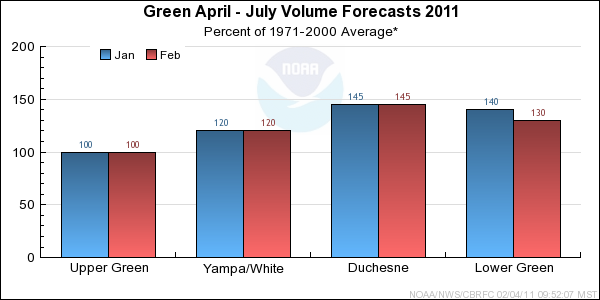
*Median of forecasts within each basin.
Upper Green Basin Conditions
The following conditions influenced this month's forecasts:
Precipitation:
Seasonal October through January
precipitation was 130 percent of average
in the Upper Green basin. January
precipitation was 75 percent of average in
the basin as a whole; however, portions of the basin such as the Ham's Fork river basin received near
average precipitation.
Snow:
February 1st snow water equivalent was 120 percent of average in the basin.
--- Upper Green basin
snow
water equivalent plot.
Streamflow:
December streamflow was near 95 percent of average.
Soil Moisture:
Modeled
soil
moisture states were below average heading into the winter.
Climate Forecasts:
Climate forecasts were not a factor because there is not a strong correlation
between La Nina conditions and winter precipitation in the Upper Green basin.
Forecast Summary:
The majority of Upper Green received below average precipitation for January.
As a result of the January precipitation, the percent of average for both snow
water equivalent and seasonal precipitation decreased from last month. However, due
to the above to much above average monthly precipitation prior to January, the
seasonal precipitation and February 1st snow water equivalent still remain above
average. As a result, April through July streamflow volumes are similar to January
or have decreased slightly. Current forecasts range between 100 and 124 percent of
average with a median value of 100 percent.
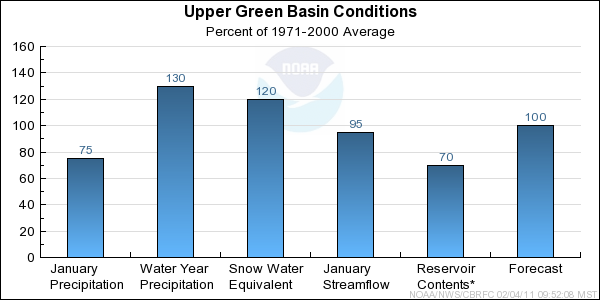
* Percent usable capacity, not percent average contents.
Click for multi-month Graph.
Yampa/White Basin Conditions
The following conditions influenced this month's forecasts:
Precipitation:
Seasonal October through January
precipitation was 140 percent of average
in the Yampa/White basin. January
precipitation was 70 percent of average in
the basin as a whole; however, portions of the basin such as the Yampa and Elk river basins received
near average precipitation.
Snow:
February 1st snow water equivalent was 125 percent of average in the basin.
--- Yampa basin
snow
water equivalent plot.
Streamflow:
January streamflow was near 95 percent of average.
Soil Moisture:
Modeled
soil
moisture states were near average heading into the winter for the Yampa, Little Snake,and
White River basins.
Climate Forecasts:
Climate forecasts were not a factor in the forecasts because there is not a strong correlation
between La Nina conditions and winter precipitation in the Yampa/White basin.
Forecast Summary:
The majority of the Yampa basin received below average precipitation for January.
As a result of the January precipitation, the percent of average for both snow
water equivalent and seasonal precipitation decreased from last month.
However, due to the much above average monthly precipitation prior to January, the
seasonal precipitation and February 1st snow water equivalent still remain much above
average. As a result, April through July streamflow volumes did not change. Current forecasts range
between 108 and 134 percent of average with a median value of 120 percent.
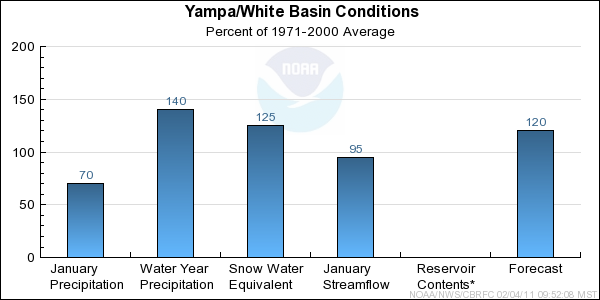
* Percent usable capacity, not percent average contents.
Click for multi-month Graph.
Duchesne Basin Conditions
The following conditions influenced this month's forecasts:
Precipitation:
Seasonal October through January
precipitation was 180 percent of average
in the Duchesne basin. January
precipitation was 40 percent of average.
Snow:
February 1st snow water equivalent was 160 percent of average in the basin
as a whole.
--- Duchesne basin
snow
water equivalent plot.
Streamflow:
January streamflow was 95 percent of average.
Soil Moisture:
Modeled
soil
moisture states were much below average to below average heading into the winter.
Climate Forecasts:
Climate forecasts were not a factor in the forecasts because there is not a strong correlation
between La Nina conditions and winter precipitation in the Duchesne basin.
Forecast Summary:
The Duchesne basin received much below average precipitation for January.
As a result of the January precipitation, the percent of average for both snow
water equivalent and seasonal precipitation decreased from last month.
However, due to the much above average monthly precipitation prior to January, the
seasonal precipitation and February 1st snow water equivalent still remain much above average. As a result, April through
July streamflow volumes did not change. Current forecasts range
between 115 and 174 percent of average with a median value of 143 percent.
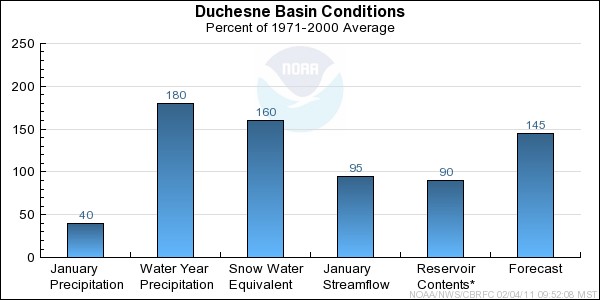
* Percent usable capacity, not percent average contents.
Click for multi-month Graph.
Lower Green Basin Conditions
The following conditions influenced this month's forecasts:
Precipitation:
Seasonal October through January
precipitation was 190 percent of average
in the Lower Green basin. February
precipitation was 30 percent of average.
Snow:
February 1st snow water equivalent was 130 percent of average in the basin
as a whole.
--- Lower Green basin
snow
water equivalent plot.
Streamflow:
January streamflow was near 130 percent of average.
Soil Moisture:
Modeled
soil
moisture states were much below to near average heading into the winter.
Climate Forecasts:
Climate forecasts were not a factor in the forecasts because there is not a strong correlation
between La Nina conditions and winter precipitation in the Lower Green basin.
Forecast Summary:
The Lower Green river basin received much below average precipitation in January.
As a result of the January precipitation, the percent of average for both snow
water equivalent and seasonal precipitation decreased from last month.
However,due to the much above average monthly precipitation prior to January, the
seasonal precipitation and February 1st snow water equivalent still remain much
above average. April through July streamflow volumes did not change or decreased
slightly. Current forecasts range between 121 and 162 percent of average with a median value of 129 percent.
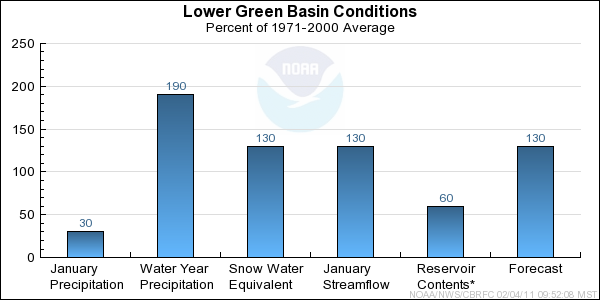
* Percent usable capacity, not percent average contents.
Click for multi-month Graph.
Differences between the full period forecasts and the residual forecasts may not exactly equal the actual observed volumes due to rounding conventions (see Definitions section).
Reservoir Monthly Inflow Forecasts
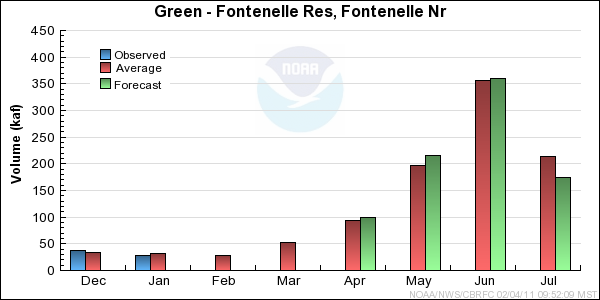
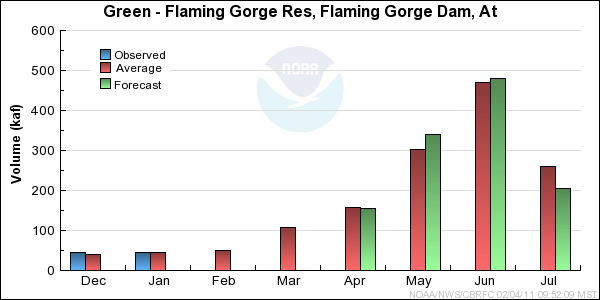
Monthly Streamflows
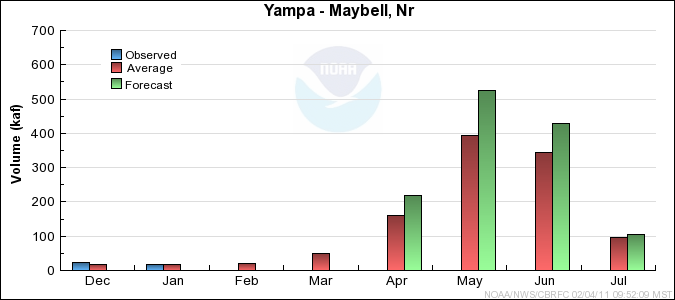
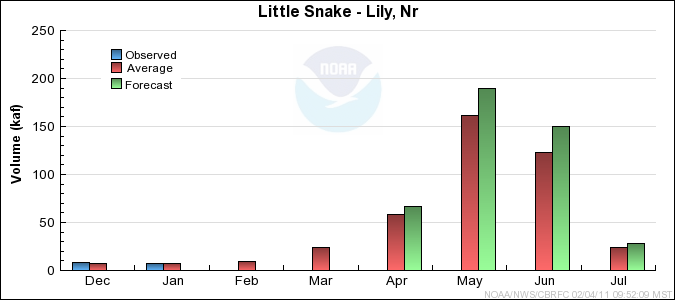
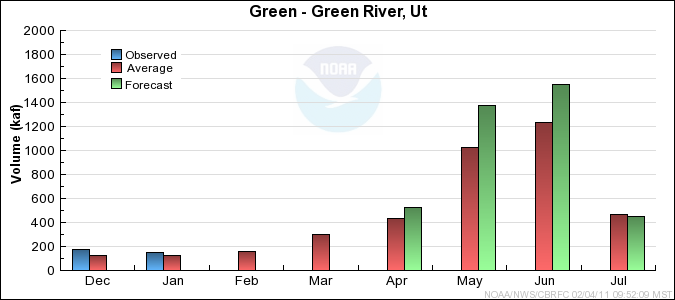
Precipitation Maps
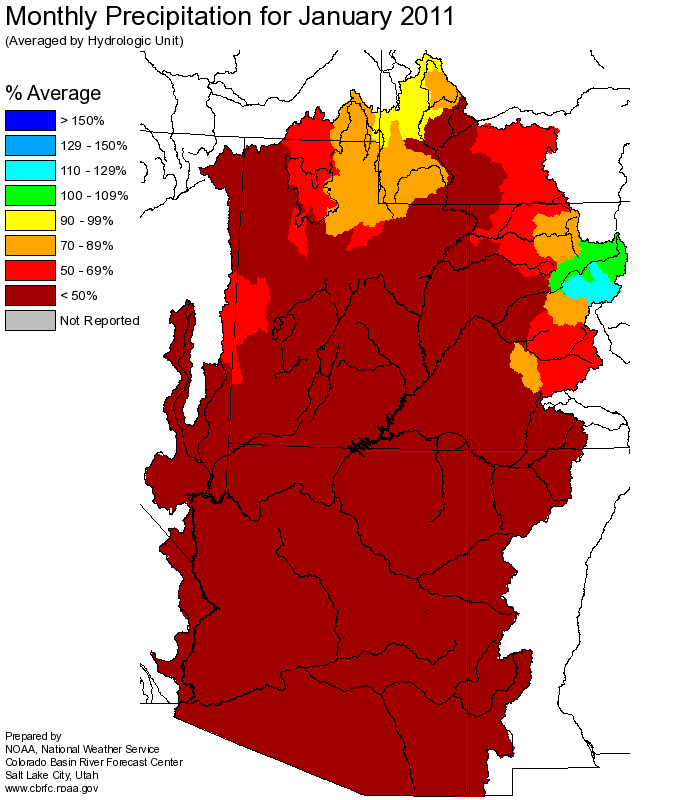
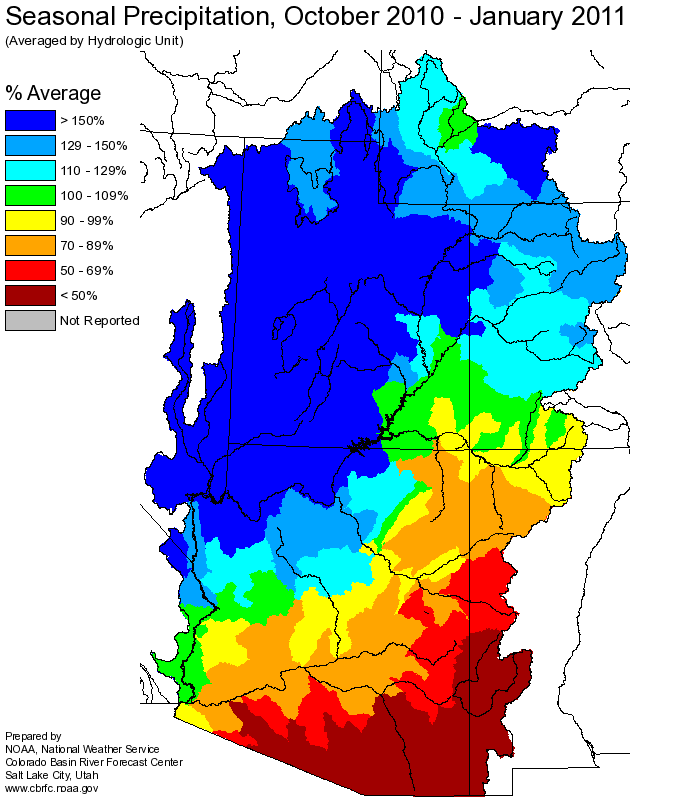
Hydrologist: Ashley Nielson













